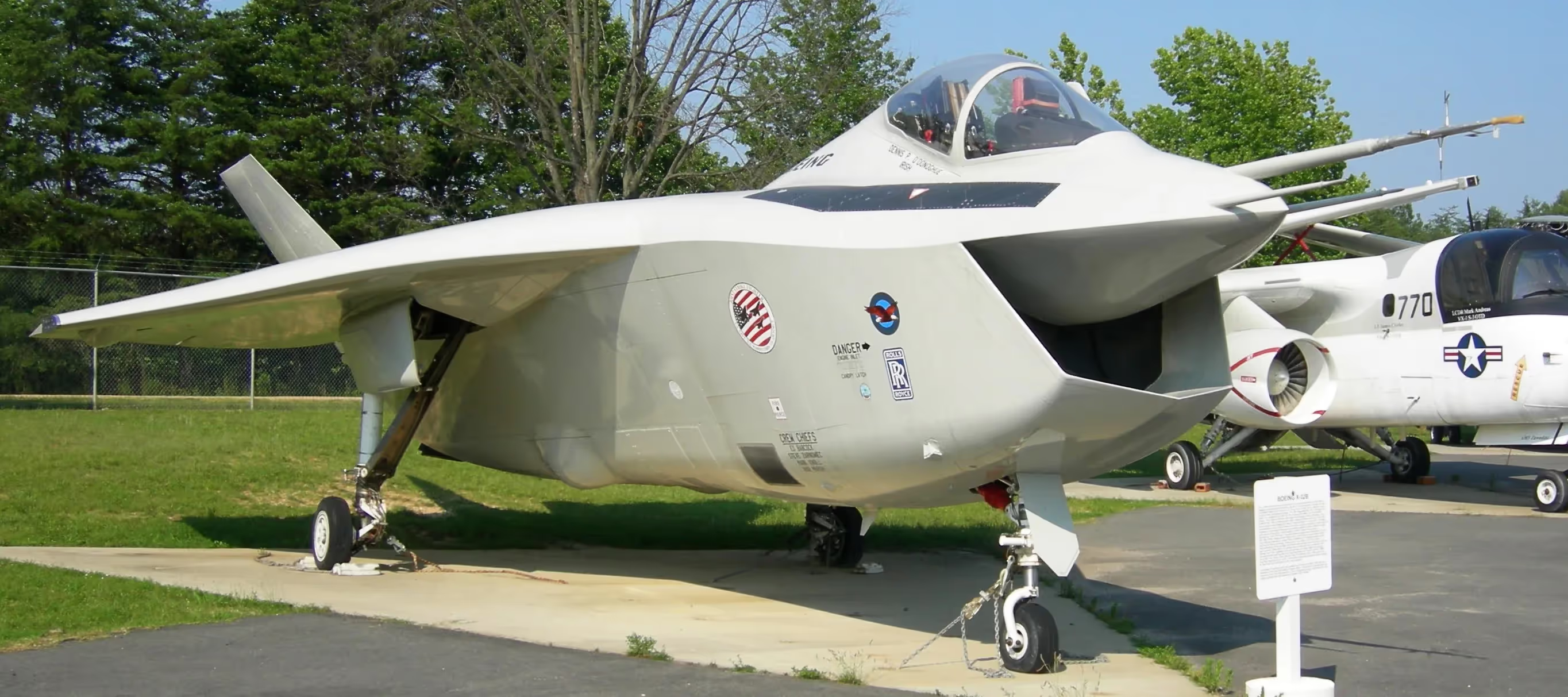Warplanes of the USA: Boeing X-32
Boeing X-32

(USAF Photo)
Boeing Joint Strike Fighter X-32B demonstrator lifting off on its maiden flight from the company's facility in Palmdale, California, 18 September 2000.
The Boeing X-32 is a concept demonstrator aircraft that was designed for the Joint Strike Fighter competition. It lost to the Lockheed Martin X-35 demonstrator, which was further developed into the Lockheed Martin F-35 Lightning II.
In 1993, the Defense Advanced Research Projects Agency (DARPA) launched the Common Affordable Lightweight Fighter project (CALF).[1] The project's purpose was to develop a stealth-enabled design to replace all of United States Department of Defense lighter weight fighter and attack aircraft, including the F-16 Fighting Falcon, McDonnell Douglas F/A-18 Hornet, and vertical/short takeoff / vertical landing (V/STOL) AV-8B Harrier II.[2] Around the same time, the Joint Advanced Strike Technology (JAST) project was started.[3] In 1994, the U.S. Congress ordered the two to be merged into the Joint Strike Fighter (JSF) program.
Many companies took part in the first phase of this project, which involved drafting concept aircraft designs for submission to the Department of Defense. On 16 November 1996, Boeing and Lockheed Martin were awarded contracts for them to produce two of their concept demonstrator aircraft (CDA) each.[4] Under the contract, these fighters were required to demonstrate conventional take-off and landing (CTOL), carrier take-off and landing (CV version), and short take-off and vertical landing (STOVL). They were also expected to include ground demonstrations of a production representative aircraft's systems, such as the Preferred Weapon System Concept (PWSC).
One major departure from previous projects was the prohibition of the companies from using their own money to finance development. Each was awarded $750 million to produce their two aircraft – including avionics, software and hardware. This limitation promoted the adoption of low cost manufacturing and assembly techniques, and also prevented either Boeing or Lockheed Martin from bankrupting themselves in an effort to win such an important contest. (Wikipedia)






(Ty Greenlees, USAF Photos)
In 2005, the Boeing X-32A was transferred to the National Museum of the United States Air Force near Dayton, Ohio. Its condition deteriorated due to being outside for several years following the end of the JSF competition. In December 2023, the museum completed a three-month-long restoration of the aircraft. On 31 May 2024, the X-32A was moved into the R&D gallery as a display, parked close to the similarly ill-fated YF-23 "Black Widow II".

(USAF Photo)
The Boeing X-32, left, and the Lockheed X-35 competed for the DoD contract to produce the Joint Strike Fighter (JSF) in 1997. Both companies received $750 million grants to build prototypes.The new single-engine, Mach-1 capable aircraft needed to be stealthy and provide robust situational awareness to the pilot during attacks on ground targets and when fighting in air-to-air engagements. It also needed to meet the specifications of the U.S. Air Force, U.S. Navy and U.S. Marine Corps as well as nation partners. Lockheed won the competition which would eventually produce the F-35 Lightning II.
.avif)
(ZLEA Photo)

(Balon Greyjoy Photo)

(Carl Lindberg Photo)
Boeing X-32B JSF STOVL Demonstrator. The Boeing X-32 is a concept demonstrator aircraft that was designed for the Joint Strike Fighter competition. It lost to the Lockheed Martin X-35 demonstrator, which was further developed into the Lockheed Martin F-35 Lightning II. The X-32B was transferred to the Patuxent River Naval Air Museum adjacent to NAS Patuxent River in St. Mary's County, Maryland in 2005. It underwent restoration at the museum's restoration facility in June 2009, but has deteriorated since. The aircraft is on display.





